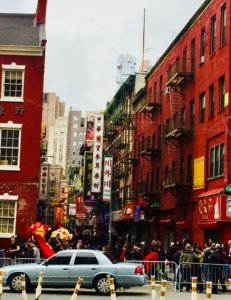The Enclave | The Passing of the Dragon | Symbolism
During the 1860s and the years of the gold rush, San Francisco’s Chinese enclave was the first to adopt America’s favorite mode of public celebration; the parade. Indeed, no precedent of public parades existed to the same extent in their native China. In the company of other community groups, the parade marched down on what is today Grant Avenue and Kearny Street carrying colorful flags, banners, lanterns, lighting firecrackers and playing drums for the quintessential event of the Chinese New Year festivities: the mythical dragon dance–a ritual that brings abundance and prosperity to partaking businesses.
The passing of the 1882 Exclusion Act prohibited job opportunities outside of the enclave and resulted in the community having to find ways to invest by itself for itself even when participating in recreational activities. This proved to be the survival of Chinatowns as tourism became an important part of the enclave’s economy and placed the Chinese under a positive light. The Lunar New Year parades came to be the social bridge that connected, in festive a manner, the mainstream culture and its people with a segregated and discriminated Chinese community during the decades of the Asian Exclusion Act.

The more modern version of the parade began in 1953, with the first Miss Chinatown pageant, as a procession went through the neighborhood to gather crowds before the contest. Against the backdrop of the Cold War, the parade served as a public campaign to welcome business and tourism, putting Chinese Americans in a more desirable position.

Starting in the 1970s, the parade expanded beyond the borders of San Francisco’s Chinatown: New York, followed in their path with the support of community associations and eventually that of the local government. Unfortunately, the successive decades presented new obstacles, like the 1997 ban on fireworks and crackers during Chinese New Year festivities, which lasted for almost ten years, much to the disappointment of the Chinese community and its visitors. As well as, and worse without comparison, the fallout of the 9/11 terrorist attack, the ensuing urban isolation (due to Chinatown’s geographical proximity to the Twin Towers) and slow economical rebuilding in a post-9/11 era. Through the united efforts of local businesses, civic associations and the City Hall authorities, Manhattan’s Chinatown experienced a makeover, boosting tourism revenue and support to the enclave; the Bloomberg administration built an information kiosk in the center of Chinatown providing tourists information while the local business associations organized campaigns to promote the retail and restaurant businesses—their main source of revenue.
The New York City Chinese New Year Parade continues to be the prime cultural celebration for Chinese-Americans’ ethnic identity. Year after year, the parade’s Nianshou dances reinforce the Chinese ethnic identity while drawing audiences of both insiders and outsiders, binding symbolism, appeal, and success within the geographical enclave and effectively amplifying and cementing their inter-cultural experience. While the core celebration remains the one at the heart of Manhattan’s Chinatown, in recent years, with Chinese settlements reaching far into Brooklyn and Queens, twin parades have begun taking place in Downtown Flushing and Brooklyn’s 8th avenue. Moreover, the Chinese New Year has not only crossed the river but also the limits of the urban enclave to become celebrated in more formal non-ethnic focused institutional centers like the Metropolitan Museum of Art, the Museum of Modern Art and the New York Public Libraries.











